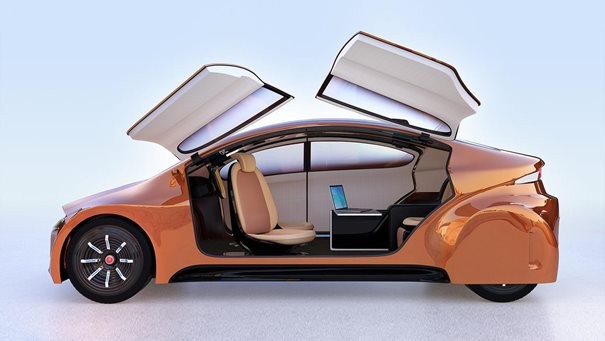Sophisticated electronic systems continue to increase their impact across today’s automotive sector. Radar, LiDAR, and a host of new artificial intelligence (AI)-based systems are becoming the norm as vehicle makers seek to improve safety, performance and efficiency on the road to fully autonomous vehicles.
In 1913, Henry Ford revolutionized manufacturing with the inauguration of the first assembly line to produce automobiles, which reduced the time to make a new car from 12 hours to 2.5 hours, and more importantly, drove down the cost by 65%. Semiconductor manufacturing has been a beneficiary of this approach, as increasing automation has been complementary to the geometry shrinking forces responsible for Moore’s Law. Both industries manufacture on a very high volume: there were approximately 87 million passenger vehicles and 87 million 300mm equivalent wafers fabricated in 2017. Today, robotics drives both industries to further cost reduction and improved quality.
 More and more, these industries are connected, as electronic systems and semiconductors become a larger part of the total automotive bill of materials, and automotive applications become a larger percentage of the total semiconductor market. At the same time, electronics are responsible for a larger portfolio of car functions, progressing rapidly towards an anticipated revolution of fully automated driving vehicles. While electronics become more safety critical in vehicle operation, the quality requirements of the semiconductor components are increasing in ways the industry has not seen before. We can see in the daily financial news the competing headlines between large strategic plays in automated driving investments and developments punctuated by reports of crashes by test vehicles and private owners pushing their cars into uncharted levels of self-driving.
More and more, these industries are connected, as electronic systems and semiconductors become a larger part of the total automotive bill of materials, and automotive applications become a larger percentage of the total semiconductor market. At the same time, electronics are responsible for a larger portfolio of car functions, progressing rapidly towards an anticipated revolution of fully automated driving vehicles. While electronics become more safety critical in vehicle operation, the quality requirements of the semiconductor components are increasing in ways the industry has not seen before. We can see in the daily financial news the competing headlines between large strategic plays in automated driving investments and developments punctuated by reports of crashes by test vehicles and private owners pushing their cars into uncharted levels of self-driving.
Market overview
Electronic systems and passenger vehicles are both significant contributors to the global economy, representing about 2% each of global GDP, and their growth is increasingly interdependent. According to NXP, electronic systems represent more than one third of the bill of materials for new cars. The chips themselves, including OSDs (optical, sensors, and discretes) now average nearly (USD) $500 per vehicle. From the semiconductor industry perspective, automotive ICs and OSDs are 13% of application sales, and growing almost twice as fast as the overall industry. Just like PCs and smartphones, we expect the chip value of the overall electronics assembly to increase as the applications become a more critical part of vehicle operation.
This growth potential has attracted attention from many of the major players in semiconductor manufacturing as they try to both directly benefit from the higher multiples of the automotive sector, and to influence what kinds of chip designs will control future vehicles.
India’s Automotive Market
The automobile industry is one of the most important drivers of economic growth of India and one with high participation in global value chains. The growth of this sector has been on the back of strong government support which has helped it carve a unique path among the manufacturing sectors of India. The automobiles produced in the country uniquely cater to the demands of low- and middle-income groups of population which makes this sector stand out among the other automobile-producing countries.
The future of the automotive chip market looks promising with opportunities in the passenger vehicle, light commercial vehicle, and electric vehicle segments. The automotive chip market is expected to grow with a CAGR of 7% from 2019 to 2024.
The major drivers for this market are rising concern for vehicle safety, stringent government regulations, growing electronic content per vehicle, increasing awareness regarding energy-efficient lighting systems, and incorporation of Engine Control Unit (ECU) in cars.
However, complexity in the design of automotive ICs hinders the market growth. The design chain of automotive IC is extremely complex than those of mobile phones or electronic home appliances, such as televisions and remote controllers. This makes the designing of highly reliable automotive ICs a difficult task.
Major players operating in the automotive IC market are Intel, Samsung, Robert Bosch, Qualcomm, Renesas Electronics Corporation, Infineon Technologies AG, STMicroelectronics, ROHM CO. LTD., Texas Instruments, ON Semiconductor and NXP Semiconductors..
Joseph Notaro, Vice President of WW Automotive Strategy and Business Development at ON Semiconductor comments on Automotive ICs growth in India.
 According to an India Brand Equity Foundation (IBEF) report, India is the fourth largest automotive market in the world and the seventh largest automotive manufacturer. 2 and 3 wheelers are still making up more than 80% of the Indian automotive market. However, economic growth, increased urbanization, and government regulations and policies are driving electronics growth in both 2/3 wheels and passenger vehicles. According to Strategy Analytics, the India Automotive Semiconductor market is expected to grow 11.8% CAGR ’18-’23 (fastest growing region worldwide) with the strongest growth coming for, Powertrain and Safety followed by Driver Info and Body. Current electronics content is Indian automotive vehicles is still low but this is expected to increase in the next years driving by increased consumer demand and government regulations on emissions and safety.
According to an India Brand Equity Foundation (IBEF) report, India is the fourth largest automotive market in the world and the seventh largest automotive manufacturer. 2 and 3 wheelers are still making up more than 80% of the Indian automotive market. However, economic growth, increased urbanization, and government regulations and policies are driving electronics growth in both 2/3 wheels and passenger vehicles. According to Strategy Analytics, the India Automotive Semiconductor market is expected to grow 11.8% CAGR ’18-’23 (fastest growing region worldwide) with the strongest growth coming for, Powertrain and Safety followed by Driver Info and Body. Current electronics content is Indian automotive vehicles is still low but this is expected to increase in the next years driving by increased consumer demand and government regulations on emissions and safety.
Green and Safe are 2 megatrends driving the growth of electronics in our cars worldwide. The need to reduce the emissions of our vehicles and eliminating deaths and casualties from our roads is a must also for India. India is home to 13 of the 20 most polluted cities in the world and 33 of the top 100. India accounts for almost 11% of the highest automotive fatalities in the world. Government norms / regulations on safety (Bharat New Vehicle Safety Assessment, BNVSAP) and emission standards (Bharat Stage –VI, BS-VI) are driving the growth in automotive electronics in Safety and Powertrain. The vision is for all new vehicles to be 100% electric by the 100th anniversary of India’s independence (2047).
Growth is expected to be driven by mandated safety equipment (anti-lock/combined braking systems, driver side airbag, speed warning alarm, rear parking sensors, front seatbelt reminders, etc) and electrification leading to emission reductions.
As a top 10 global automotive semiconductor supplier and leader in power, image sensing, ultrasonic sensor interfaces, LED lighting and ignition, ON semiconductor is uniquely positioned to enable this growth in India. We have low-, medium- and high-voltage power devices (PowerMOS, IGBT, Diodes) that are electrifying 2-, 3- wheelers and passenger vehicles. Our sensing solutions (image, ultrasonic,) and power products are essential for helping to make Indian cars safer.






